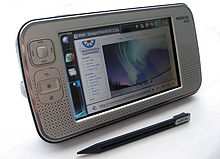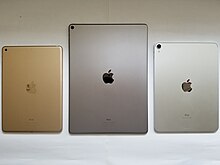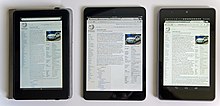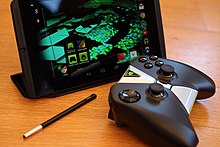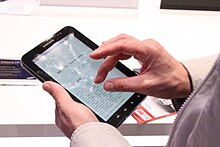From Wikipedia, the free encyclopedia
A
tablet computer, commonly shortened to
tablet, is a
mobile device, typically with a
mobile operating system and
touchscreen display processing
circuitry, and a
rechargeable battery in a single, thin and flat package. Tablets, being computers, do what other
personal computers do, but lack some
input/output (I/O) abilities that others have. Modern tablets largely resemble modern
smartphones,
the only differences being that tablets are relatively larger than
smartphones, with screens 7 inches (18 cm) or larger, measured
diagonally, and may not support access to a
cellular network.
The touchscreen display is operated by
gestures executed by finger or
digital pen (stylus), instead of the
mouse,
trackpad, and
keyboard
of larger computers. Portable computers can be classified according to
the presence and appearance of physical keyboards. Two species of
tablet, the
slate and
booklet, do not have physical keyboards and usually accept text and other input by use of a
virtual keyboard
shown on their touchscreen displays. To compensate for their lack of a
physical keyboard, most tablets can connect to independent physical
keyboards by
Bluetooth or
USB;
2-in-1 PCs have keyboards, distinct from tablets.
The form of the tablet was conceptualized in the middle of the 20th century (
Stanley Kubrick depicted fictional tablets in the 1968
science fiction film
A Space Odyssey) and prototyped and developed in the last two decades of that century. In 2010,
Apple released the
iPad, the first mass-market tablet to achieve widespread popularity.
Thereafter tablets rapidly rose in ubiquity and soon became a large
product category used for personal, educational and workplace
applications, with sales stabilizing in the mid-2010s.
History
Fictional and prototype tablets
Tablet computers appeared in a number of works of
science fiction in the second half of the
20th century; all helped to promote and disseminate the concept to a wider audience.
[16] Examples include:
Further, real-life projects either proposed or created tablet computers, such as:
- In 1968, computer scientist Alan Kay envisioned a KiddiComp; he developed and described the concept as a Dynabook in his proposal, A personal computer for children of all ages (1972), which outlines functionality similar to that supplied via a laptop
computer, or (in some of its other incarnations) a tablet or slate
computer, with the exception of near eternal battery life. Adults could
also use a Dynabook, but the target audience was children.
- In 1979, the idea of a touchscreen tablet that could detect an external force applied to one point on the screen was patented in Japan by a team at Hitachi
consisting of Masao Hotta, Yoshikazu Miyamoto, Norio Yokozawa and
Yoshimitsu Oshima, who later received a US patent for their idea.
- In 1992, Atari showed developers the Stylus, later renamed ST-Pad. The ST-Pad was based on the TOS/GEM Atari ST Platform and prototyped early handwriting recognition. Shiraz Shivji's company Momentus demonstrated in the same time a failed x86 MS-DOS based Pen Computer with its own graphical user interface (GUI).
- In 1994, the European Union initiated the NewsPad project, inspired by Clarke and Kubrick's fictional work. Acorn Computers developed and delivered an ARM-based touch screen tablet computer for this program, branding it the "NewsPad"; the project ended in 1997.
- During the November 2000 COMDEX, Microsoft used the term Tablet PC to describe a prototype handheld device they were demonstrating.
- In 2001, Ericsson Mobile Communications
announced an experimental product named the DelphiPad, which was
developed in cooperation with the Centre for Wireless Communications in Singapore, with a touch-sensitive screen, Netscape Navigator as a web browser, and Linux as its operating system.
Early tablets
Following earlier tablet computer products such as the
Pencept PenPad, and the CIC Handwriter, in September 1989,
GRiD Systems released the first commercially successful tablet computer, the
GRiDPad. All three products were based on extended versions of the
MS-DOS operating system. In 1992, IBM announced (in April) and shipped to developers (in October) the 2521 ThinkPad, which ran the
GO Corporation's
PenPoint OS. Also based on PenPoint was AT&T's
EO Personal Communicator from 1993, which ran on AT&T's own hardware, including their own
AT&T Hobbit CPU. Apple Computer launched the
Apple Newton personal digital assistant in 1993. It used Apple's own new
Newton OS, initially running on hardware manufactured by Motorola and incorporating an
ARM CPU, that Apple had specifically co-developed with
Acorn Computers. The operating system and platform design were later licensed to
Sharp and
Digital Ocean, who went on to manufacture their own variants.
In 1996,
Palm, Inc. released the first of the
Palm OS based
PalmPilot touch and stylus based PDA, the touch based devices initially incorporating a
Motorola Dragonball
(68000) CPU. Also in 1996 Fujitsu released the Stylistic 1000 tablet
format PC, running Microsoft Windows 95, on a 100 MHz AMD486 DX4 CPU,
with 8 MB RAM offering stylus input, with the option of connecting a
conventional Keyboard and mouse. Intel announced a
StrongARM processor-based touchscreen tablet computer in 1999, under the name WebPAD. It was later re-branded as the "Intel Web Tablet". In 2000, Norwegian company Screen Media AS and the German company Dosch & Amand Gmbh released the " FreePad". It was based on Linux and used the
Opera browser.
Internet access was provided by
DECT
DMAP, only available in Europe and provided up to 10Mbit/s. The device
had 16 MB storage, 32 MB of RAM and x86 compatible 166 MHz
"Geode"-Microcontroller by
National Semiconductor.
The screen was 10.4" or 12.1" and was touch sensitive. It had slots for
SIM cards to enable support of television set-up box. FreePad were sold
in Norway and the Middle East; but the company was dissolved in 2003.
In April 2000,
Microsoft launched the
Pocket PC 2000, using their touch capable
Windows CE 3.0 operating system. The devices were manufactured by several manufacturers, based on a mix of:
x86,
MIPS,
ARM, and
SuperH hardware. In 2002, Microsoft attempted to define the
Microsoft Tablet PC as a mobile computer for field work in business, though their devices failed, mainly due to pricing and
usability
decisions that limited them to their original purpose - such as the
existing devices being too heavy to be held with one hand for extended
periods, and having legacy applications created for desktop interfaces
and not well adapted to the slate format.
Nokia had plans for an
Internet tablet since before 2000. An early model was test manufactured in 2001, the Nokia M510, which was running on
EPOC and featuring an
Opera browser, speakers and a 10-inch 800×600 screen, but it was not released because of fears that the market was not ready for it. Nokia entered the tablet space in May 2005 with the
Nokia 770 running
Maemo, a Debian-based Linux distribution custom-made for their
Internet tablet line. The
user interface and
application framework layer, named
Hildon, was an early instance of a
software platform for generic computing in a tablet device intended for internet consumption.
But Nokia didn't commit to it as their only platform for their future
mobile devices and the project competed against other in-house platforms
and later replaced it with the
Series 60. Nokia used the term
internet tablet to refer to a portable
information appliance that focused on Internet use and media consumption, in the range between a
personal digital assistant (PDA) and an
Ultra-Mobile PC (UMPC). They made two mobile phones, the N900 that runs Maemo, and N9 that run Meego.
Before the release of iPad, Axiotron introduced an aftermarket, heavily modified Apple
MacBook called
Modbook, a
Mac OS X-based tablet computer. The Modbook uses Apple's
Inkwell for handwriting and gesture recognition, and uses digitization hardware from
Wacom. To get Mac OS X to talk to the digitizer on the integrated tablet, the Modbook was supplied with a third-party driver.
Following the launch of the
Ultra-mobile PC, Intel began the
Mobile Internet Device
initiative, which took the same hardware and combined it with a
tabletized Linux configuration. Intel codeveloped the lightweight
Moblin (mobile Linux) operating system following the successful launch of the Atom CPU series on netbooks. In 2010, Nokia and
Intel
combined the Maemo and Moblin projects to form MeeGo, a Linux-based
operating system supports netbooks and tablets. The first tablet using
MeeGo was the
Neofonie WeTab
launched September 2010 in Germany. The WeTab used an extended version
of the MeeGo operating system called WeTab OS. WeTab OS adds runtimes
for Android and
Adobe AIR and provides a proprietary user interface optimized for the WeTab device. On September 27, 2011 the
Linux Foundation announced that MeeGo would be replaced in 2012 by
Tizen.
Modern tablets
Android was the first of the 2000s-era dominating platforms for
tablet computers to reach the market. In 2008, the first plans for
Android-based tablets appeared. The first products were released in
2009. Among them was the Archos 5, a pocket-sized model with a 5-inch
touchscreen,
that was first released with a proprietary operating system and later
(in 2009) released with Android 1.4. The Camangi WebStation was released
in Q2 2009. The first
LTE Android tablet appeared late 2009 and was made by ICD for
Verizon.
This unit was called the Ultra, but a version called Vega was released
around the same time. Ultra had a 7-inch display while Vega's was 15
inches. Many more products followed in 2010. Several manufacturers
waited for
Android Honeycomb, specifically adapted for use with tablets, which debuted in February 2011.
Apple is often credited for defining a new class of consumer device with the
iPad, which shaped the commercial market for tablets in the following years,
and was the most successful tablet at the time of its release. iPads
and competing devices were tested by the US military in 2011 and cleared for secure use in 2013. Its debut in 2010 pushed tablets into the mainstream.
Samsung's Galaxy Tab and others followed, continuing the trends towards the features listed above. In March 2012,
PC Magazine reported that 31% of U.S. Internet users owned a tablet, used mainly for viewing published content such as video and news. The top-selling line of devices was Apple's
iPad with 100 million sold between its release in April 2010 and mid-October 2012, but iPad
market share (number of units) dropped to 36% in 2013 with
Android
tablets climbing to 62%. Android tablet sales volume was 121 million
devices, plus 52 million, between 2012 and 2013 respectively. Individual brands of Android operating system devices or compatibles follow iPad with Amazon's
Kindle Fire with 7 million, and Barnes & Noble's
Nook with 5 million.
The
BlackBerry PlayBook was announced in September 2010 that ran the
BlackBerry Tablet OS. The BlackBerry PlayBook was officially released to US and Canadian consumers on April 19, 2011.
Hewlett Packard announced that the
TouchPad, running
WebOS 3.0 on a 1.2 GHz
Qualcomm Snapdragon
CPU, would be released in June 2011. On August 18, 2011, HP announced
the discontinuation of the TouchPad, due to sluggish sales. In 2013, the
Mozilla Foundation announced a prototype tablet model with
Foxconn which ran on
Firefox OS. Firefox OS was discontinued in 2016. The
Canonical hinted that
Ubuntu would be available on tablets by 2014. In February 2016 there was a commercial release of the
BQ Aquaris Ubuntu tablet utilizing the
Ubuntu Touch operating system. Canonical terminated support for the project due to lack of market interest on 5 April 2017 and it was then adopted by the UBports as a community project.
As of February 2014, 83% of mobile app developers were targeting tablets,
but 93% of developers were targeting smartphones. By 2014 around 23% of
B2B companies were said to have deployed tablets for sales-related
activities, according to a survey report by Corporate Visions.
The iPad held majority use in North America, Western Europe, Japan,
Australia, and most of the Americas. Android tablets were more popular
in most of Asia (China and Russia an exception), Africa and Eastern
Europe. In 2015 tablet sales did not increase. Apple remained the
largest seller but its market share declined below 25%.
Samsung
vice president Gary Riding said early in 2016 that tablets were only
doing well among those using them for work. Newer models were more
expensive and designed for a keyboard and stylus, which reflected the
changing uses.
As of early 2016, Android reigned over the market with 65%. Apple took
the number 2 spot with 26%, and Windows took a distant third with the
remaining 9%.
In 2018, out of 4.4 billion computing devices Android accounted for 2
billion, iOS for 1 billion, and the remainder were PCs, in various forms
(desktop, notebook, or tablet), running various operating systems
(Windows, macOS, ChromeOS, Linux, etc.).
In late 2017, the
iPad Pro received the
iOS 11 update, adding the ability to run multiple windows, drag and drop from one app to another, and browse a user's files.
Types
Samsung's Galaxy Note series were the first commercially successful phablets
Lenovo Yoga, a 2-in-1 convertible tablet, with a physical keyboard that can be folded at any angle
Tablets can be loosely grouped into several categories by physical
size, kind of operating system installed, input and output technology,
and uses.
Slate
The size of a slate varies, but slates begin at 6 inches (approximately 15 cm). Some models in the larger than 10-inch (25 cm) category include the
Samsung Galaxy Tab Pro 12.2 at 12.2 inches (31 cm), the Toshiba Excite at 13.3 inches (33 cm) and the Dell XPS 18 at 18.4 inches (47 cm). As of March 2013, the thinnest tablet on the market was the
Sony Xperia Tablet Z at only 0.27 inches (6.9 mm) thick. On September 9, 2015, Apple released the
iPad Pro with a 12.9 inches (33 cm) screen size, larger than the regular
iPad.
Mini tablet
Mini
tablets are smaller and weigh less than slates, with typical screen
sizes between 7–8 inches (18–20 cm). The first commercially successful
mini tablets were introduced by
Amazon.com (
Kindle Fire),
Barnes & Noble (
Nook Tablet), and
Samsung (
Galaxy Tab) in 2011; and by
Google (
Nexus 7) in 2012. They operate identically to ordinary tablets but have lower specifications compared to them.
On September 14, 2012,
Amazon, Inc. released an upgraded version of the
Kindle Fire, the
Kindle Fire HD, with higher screen resolution and more features compared to its predecessor, yet remaining only 7 inches. In October 2012, Apple released the
iPad Mini with a 7.9 inch screen size, about 2 inches smaller than the regular
iPad, but less powerful than the then current
iPad 3. On July 24, 2013, Google released an upgraded version of the
Nexus 7, with FHD display, dual cameras, stereo speakers, more color accuracy, performance improvement, built-in
wireless charging,
and a variant with 4G LTE support for AT&T, T-Mobile, and Verizon.
In September 2013, Amazon further updated the Fire tablet with the
Kindle Fire HDX. In November 2013, Apple released the
iPad Mini 2, which remained at 7.9 inches and nearly matched the hardware of the
iPad Air.
Phablet
Smartphones and tablets are similar devices, differentiated by the former typically having smaller screens and most tablets lacking
cellular network capability. Since 2010, crossover touchscreen
smartphones with screens larger than 5 inches have been released. That size is generally considered larger than a traditional
smartphone, creating the hybrid category of the
phablet by
Forbes and other publications. "Phablet" is a
portmanteau of "phone" and "tablet".
At the time of the introduction of the first phablets, they had
screens of 5.3 to 5.5 inches, but as of 2017 screen sizes up to 5.5
inches are considered typical. Examples of phablets from 2017 and onward
are the
Samsung Galaxy Note series (newer models of 5.7 inches), the
LG V10/
V20 (5.7 inches), the
Sony Xperia XA Ultra [6 inches], the
Huawei Mate 9 (5.9 inches), and the Huawei Honor (MediaPad) X2 (7 inches).
2-in-1
Distinct from tablets,
2-in-1 PCs all have physical
keyboards,
but they are either concealable by folding them back and under the
touchscreen ("2-in-1 convertible") or detachable ("2-in-1 detachable"),
but 2-in-1s typically also can display a virtual keyboard on their
touchscreens when their physical keyboards are concealed or detached.
Some 2-in-1s have processors and operating systems like those of
laptops, while having the flexibility of operation as a tablet. A 2-in-1 PC is a hybrid or combination of a tablet and
laptop computer that has features of both. An essential feature of a 2-in-1 is a desktop
operating system, such as
Windows 10, as opposed to a mobile operating system. Further, 2-in-1s may have typical laptop
I/O ports, such as
USB 3 and
DisplayPort, and may connect to traditional
PC peripheral devices
and external displays. Thus, they are distinct from tablets, although
they can operate just like them. Simple tablets are mainly used as
media consumption devices, while 2-in-1s have capacity for both
media consumption and
content creation, and thus 2-in-1s are often called
laptop or
desktop replacement computers.
There are two species of 2-in-1s:
- Convertibles have a chassis
design by which their physical keyboard may be concealed by
flipping/folding the keyboard behind the chassis. Examples include
2-in-1 PCs of the Lenovo Yoga series.
- Detachables or Hybrids have physical keyboards that may be detached from their chassis, even while the 2-in-1 is operating. Examples include 2-in-1 PCs of the Asus Transformer Pad and Book series, the iPad Pro, and the Microsoft Surface Book and Surface Pro.
Gaming tablet
Some tablets are modified by adding physical
gamepad buttons such as
D-pad and thumb sticks for better gaming experience combined with the
touchscreen and all other features of a typical tablet computer. Most of these tablets are targeted to run native OS games and
emulator games.
Nvidia's
Shield Tablet, with an 8-inch (200 mm) display, and running
Android, is an example. It runs Android games purchased from
Google Play store.
PC games can also be
streamed to the tablet from computers with some higher end models of Nvidia-powered
video cards. The
Nintendo Switch hybrid console is also a gaming tablet that runs on
Nintendo Switch system software, features detachable
Joy-Con
controllers with motion controls and three gaming modes: table-top mode
using its kickstand, traditional docked/TV mode and handheld mode.
Booklet
Customized business tablet
Customized
business tablets are built specifically for a business customer's
particular needs from a hardware and software perspective, and delivered
in a
business-to-business transaction. For example, in hardware, a transportation company may find that the consumer-grade
GPS module in an
off-the-shelf
tablet provides insufficient accuracy, so a tablet can be customized
and embedded with a professional-grade antenna to provide a better GPS
signal. Such tablets may also be
ruggedized
for field use. For a software example, the same transportation company
might remove certain software functions in the Android system, such as
the internet browser, to reduce costs from needless cellular network
data consumption of an employee, and add custom package management
software. Other applications may call for a
resistive touchscreen and other special hardware and software.
Games on a Ziosk table ordering tablet at an Olive Garden restaurant
A table ordering tablet is a touchscreen tablet computer designed for use in
casual restaurants. Such devices allow users to order food and drinks, play games and pay their bill. Since 2013,
restaurant chains including
Chili's,
Olive Garden and
Red Robin have adopted them. As of 2014, the two most popular brands were
Ziosk and
Presto.
The devices have been criticized by servers who claim that some
restaurants determine their hours based on customer feedback in areas
unrelated to service.
Hardware
System architecture
Two major architectures dominate the tablet market,
ARM Holdings'
ARM architecture and Intel's and AMD's
x86. Intel's x86, including
x86-64
has powered the "IBM compatible" PC since 1981 and Apple's Macintosh
computers since 2006. The CPUs have been incorporated into tablet PCs
over the years and generally offer greater performance along with the
ability to run full versions of Microsoft
Windows, along with Windows desktop and enterprise applications. Non-Windows based x86 tablets include the
JooJoo. Intel announced plans to enter the tablet market with its
Atom in 2010. In October 2013, Intel's foundry operation announced plans to build FPGA-based quad cores for ARM and x86 processors.
ARM has been the CPU architecture of choice for manufacturers of smartphones (95% ARM), PDAs, digital cameras (80% ARM),
set-top boxes, DSL routers, smart televisions (70% ARM), storage devices and tablet computers (95% ARM).
This dominance began with the release of the mobile-focused and
comparatively power-efficient 32-bit ARM610 processor originally
designed for the
Apple Newton
in 1993 and ARM3-using Acorn A4 laptop in 1992. The chip was adopted by
Psion, Palm and Nokia for PDAs and later smartphones, camera phones,
cameras, etc. ARM's licensing model supported this success by allowing
device manufacturers to license, alter and fabricate custom SoC
derivatives tailored to their own products. This has helped
manufacturers extend battery life and shrink component count along with
the size of devices.
The multiple licensees ensured that multiple fabricators could
supply near-identical products, while encouraging price competition.
This forced unit prices down to a fraction of their x86 equivalents. The
architecture has historically had limited support from Microsoft, with
only
Windows CE
available, but with the 2012 release of Windows 8, Microsoft announced
added support for the architecture, shipping their own ARM-based tablet
computer, branded the
Microsoft Surface, as well as an x86-64 Intel Core i5 variant branded as Microsoft Surface Pro. Intel tablet chip sales were 1 million units in 2012, and 12 million units in 2013.
Intel chairman Andy Bryant has stated that its 2014 goal is to
quadruple its tablet chip sales to 40 million units by the end of that
year, as an investment for 2015.
Display
A key component among tablet computers is touch input on a
touchscreen liquid-crystal display (LCD). This allows the user to navigate easily and type with a
virtual keyboard on the screen or press other icons on the screen to open apps or files. The first tablet to do this was the
GRiDPad by
GRiD Systems Corporation; the tablet featured both a
stylus, a pen-like tool to aid with precision in a touchscreen device as well as an on-screen keyboard.
The system must respond to on-screen touches rather than clicks of a
keyboard or mouse. This operation makes precise use of our
eye–hand coordination.
Touchscreens usually come in one of two forms:
- Resistive touchscreens are passive and respond to pressure on the screen. They allow a high level of precision, useful in emulating a pointer
(as is common in tablet computers) but may require calibration. Because
of the high resolution, a stylus or fingernail is often used.
Stylus-oriented systems are less suited to multi-touch.
- Capacitive touchscreens
tend to be less accurate, but more responsive than resistive devices.
Because they require a conductive material, such as a fingertip, for
input, they are not common among stylus-oriented devices but are
prominent on consumer devices. Most finger-driven capacitive screens do
not currently support pressure input (except for the iPhone 6S and later models), but some tablets use a pressure-sensitive stylus or active pen.
- Some tablets can recognize individual palms, while some
professional-grade tablets use pressure-sensitive films, such as those
on graphics tablets. Some capacitive touch-screens can detect the size of the touched area and the pressure used.
Handwriting recognition
Chinese characters like this one meaning "person" can be written by handwriting recognition ( , Mandarin: rén, Korean: in, Japanese: jin, nin; hito, Cantonese:
jan4). The character has two strokes, the first shown here in brown,
and the second in red. The black area represents the starting position
of the writing instrument.
, Mandarin: rén, Korean: in, Japanese: jin, nin; hito, Cantonese:
jan4). The character has two strokes, the first shown here in brown,
and the second in red. The black area represents the starting position
of the writing instrument.
Some ARM powered tablets, such as the
Galaxy Note 10, support a stylus and support
handwriting recognition.
Wacom and
N-trig
digital pens provide approximately 2500 DPI resolution for handwriting,
exceeding the resolution of capacitive touch screens by more than a
factor of 10. These pens also support pressure sensitivity, allowing for
"variable-width stroke-based" characters, such as
Chinese/Japanese/Korean writing, due to their built-in capability of
"pressure sensing". Pressure is also used in digital art applications
such as
Autodesk Sketchbook.
Apps exist on both iOS and Android platforms for handwriting
recognition and in 2015 Google introduced its own handwriting input with
support for 82 languages.
Other features
Other features are: High-definition,
anti-glare display, touchscreen, lower weight and longer
battery life than a comparably-sized laptop, wireless local area and internet connectivity (usually with
Wi-Fi standard and optional
mobile broadband),
Bluetooth for connecting peripherals and communicating with local devices, ports for wired connections and charging, for example
USB ports, Early devices had IR support and could work as a TV
remote controller,
docking station, keyboard and added connectivity, on-board
flash memory, ports for removable storage, various
cloud storage services for backup and
syncing data across devices, local storage on a
local area network (LAN).
- Speech recognition Google introduced voice input in Android 2.1 in 2009 and voice actions in 2.2 in 2010, with up to five languages (now around 40).[125] Siri was introduced as a system-wide personal assistant on the iPhone 4S
in 2011 and now supports nearly 20 languages. In both cases, the voice
input is sent to central servers to perform general speech recognition
and thus requires a network connection for more than simple commands.
- Near field communication with other compatible devices including ISO/IEC 14443 RFID tags.
Software
Operating system
Tablets, like conventional PCs, use several different
operating systems, though
dual-booting is rare. Tablet operating systems come in two classes:
Desktop OS-based tablets are currently thicker and heavier. They require more storage and
more cooling and give less battery life. They can run processor-intensive graphical applications in addition to
mobile apps, and have more
ports.
Mobile-based tablets are the reverse, and run only mobile apps.
They can use battery life conservatively because the processor is
significantly smaller. This allows the battery to last much longer than
the common laptop.
In Q1 2018, Android tablets had 62% of the market, Apple's iOS had 23.4% of the market and Windows 10 had 14.6% of the market.
Android
Android is a
Linux-based
operating system that Google offers as
open source under the
Apache license. It is designed primarily for mobile devices such as
smartphones and tablet computers. Android supports low-cost
ARM systems and others. The first tablets running Android were released in 2009. Vendors such as Motorola and Lenovo delayed deployment of their tablets until after 2011, when Android was reworked to include more tablet features.
Android 3.0 (Honeycomb), released in 2011 and later versions support
larger screen sizes, mainly tablets, and have access to the
Google Play service. Android includes operating system,
middleware and key applications. Other vendors sell customized Android tablets, such as
Kindle Fire and
Nook, which are used to consume
mobile content and provide their own app store, rather than using the larger
Google Play system, thereby fragmenting the Android market.
Chrome OS
iOS
The iPad runs on
iOS, which was created for the
iPhone and
iPod Touch. The first iPad was released in 2010. Although built on the same underlying
Unix
implementation as MacOS, its user interface is radically different. iOS
is designed for fingers and has none of the features that required a
stylus on earlier tablets. Apple introduced
multi-touch gestures, such as moving two fingers apart or together to zoom in or out, also termed
pinch to zoom. iOS is built for the
ARM architecture.
Windows
Following
Windows for Pen Computing for Windows 3.1 in 1991, Microsoft supported tablets running Windows XP under the
Microsoft Tablet PC name. Microsoft Tablet PCs were pen-based, fully functional
x86 PCs with handwriting and voice recognition functionality.
Windows XP Tablet PC Edition provided pen support. Tablet support was added to both Home and Business versions of
Windows Vista and
Windows 7.
Tablets running Windows could use the touchscreen for mouse input, hand
writing recognition and gesture support. Following Tablet PC, Microsoft
announced the
Ultra-mobile PC initiative in 2006 which brought Windows tablets to a smaller, touch-centric form factor. In 2008, Microsoft showed a prototype of a two-screen tablet called
Microsoft Courier, but cancelled the project.
In 2012, Microsoft released
Windows 8,
which features significant changes to various aspects of the operating
system's user interface and platform which are designed for touch-based
devices such as tablets. The operating system also introduced an
application store and a new style of application optimized primarily for use on tablets. Microsoft also introduced
Windows RT, an edition of Windows 8 for use on ARM-based devices.
The launch of Windows 8 and RT was accompanied by the release of
devices with the two operating systems by various manufacturers
(including Microsoft themselves, with the release of
Surface), such as slate tablets, hybrids, and convertibles.
Hybrid OS operation
Several
hardware companies have built hybrid devices with the possibility to
work with both the Windows 10 and Android operating systems.
Application store
Apps that do not come pre-installed with the system are supplied through
online distribution. These sources, termed
app stores, provide centralized catalogs of software and allow "one click" on-device software purchasing, installation and updates.
Mobile device suppliers may adopt a
"walled garden" approach, wherein the supplier controls what software applications ("
apps") are available.
Software development kits are restricted to approved software developers. This can be used to reduce the impact of
malware, provide software with an approved
content rating, control application quality and exclude competing vendors. Apple, Google, Amazon, Microsoft and
Barnes & Noble all adopted the strategy. B&N originally allowed arbitrary apps to be installed, but, in December 2011, excluded third parties. Apple and IBM have agreed to cooperate in
cross-selling IBM-developed applications for iPads and iPhones in enterprise-level accounts.
Proponents of open source software say that it violates the spirit of
personal control that traditional personal computers have always
provided.
Sales
Around
2010, tablet use by businesses jumped, as business began to use them for
conferences, events, and trade shows. In 2012, Intel reported that
their tablet program improved productivity for about 19,000 of their
employees by an average of 57 minutes a day. In October 2012, display screen shipments for tablets began surpassing shipments for laptop display screens. Tablets are increasingly used in the
construction industry to look at
blueprints, field documentation and other relevant information on the device instead of carrying around large amounts of paper.
As of the start of 2014, 44% of US online consumers own tablets, a significant jump from 5% in 2011.
Tablet use has also become increasingly common among children. A 2014
survey found that mobiles were the most frequently used object for play
among American children under the age of 12. Mobiles were used more
often in play than video game consoles, board games, puzzles, play
vehicles, blocks and dolls/action figures. Despite this, the majority of
parents said that a mobile was "never" or only "sometimes" a toy. As of 2014, nearly two-thirds of American 2- to 10-year-olds have access to a tablet or
e-reader. The large use of tablets by adults is as a personal internet-connected TV. A 2015 study found that a third of children under five have their own tablet device. By 2017, tablet sales worldwide had surpassed sales of desktop computers, and worldwide PC sales were flat for the first quarter of 2018.
By operating system
According to a survey conducted by the Online Publishers Association (OPA) now called
Digital Content Next (DCN) in March 2012, it found that 72% of tablet owners had an iPad, while 32% had an
Android
tablet. By 2012, Android tablet adoption had increased. 52% of tablet
owners owned an iPad, while 51% owned an Android-powered tablet
(percentages do not add up to 100% because some tablet owners own more
than one type). By end of 2013, Android's market share rose to 61.9%, followed by iOS at 36%. By late 2014, Android's market share rose to 72%, followed by iOS at 22.3% and Windows at 5.7%. As of early 2016, Android has 65% marketshare, Apple has 26% and Windows has 9% marketshare. In Q1 2018, Android tablets had 62% of the market, Apple's iOS had 23.4% of the market and Windows 10 had 14.6% of the market.
Use
Sleep
The blue wavelength of light from back-lit tablets may impact one's
ability to fall asleep when reading at night, through the suppression of
melatonin. Experts at
Harvard Medical School
suggest limiting tablets for reading use in the evening. Those who have
a delayed body clock, such as teenagers, which makes them prone to stay
up late in the evening and sleep later in the morning, may be at
particular risk for increases in sleep deficiencies. A PC app such as
F.lux and Android apps such as CF.lumen and Twilight attempt to decrease the impact on sleep by filtering blue wavelengths from the display.
iOS 9.3 includes
Night Shift that shifts the colors of the device's display to be warmer during the later hours.
By plane
Because
of, among other things, electromagnetic waves emitted by this type of
device, the use of any type of electronic device during the take-off and
landing phases was totally prohibited on board commercial flights. On
13 November 2013, the
European Aviation Safety Agency
(EASA) announced that the use of mobile terminals could be authorized
on the flights of European airlines during these phases from 2014
onwards, on the condition that the cellular functions are deactivated
("airplane" mode activated).
In September 2014, EASA issued guidance that allows EU airlines to
permit use of tablets, e-readers, smartphones, and other portable
electronic devices to stay on without the need to be in airplane mode
during all parts of EU flights, however each airline has to decide to
allow this behavior. In the US, the
Federal Aviation Administration allowed use of portable electronic devices during all parts of flights while in airplane mode in late 2013.
Tourism
Some French historical monuments are equipped with digital tactile tablets called "HistoPad". It is an application integrated with an
IPad Mini
offering an interaction in augmented and virtual reality with several
pieces of the visit, the visitor being able to take control of his visit
in an interactive and personalized way.
Professional use for specific sectors
Some
professionals - for example, in the construction industry, insurance
experts, lifeguards or surveyors - use so-called rugged shelf models in
the field that can withstand extreme hot or cold shocks or climatic
environments. Some units are hardened against drops and screen breakage.
Satellite-connectivity-equipped tablets such as the Thorium X,
for example, can be used in areas where there is no connectivity. This
is a valuable feature in the aeronautical and military realms. For
example, United States Army helicopter pilots are moving to tablets as
electronic flight bags,
which confer the advantages of rapid, convenient synchronization of
large groups of users, and the seamless updating of information.







